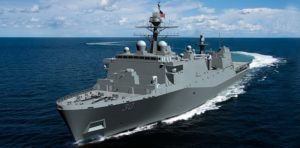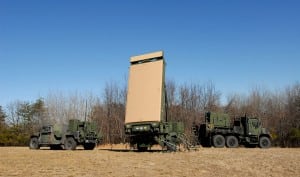The Marine Corps is asking Congress to fund the next amphibious ship early, in opposition to Navy plans, according to the service’s latest wish list to lawmakers.
According to a copy of the Marine Corps’ fiscal year 2024 unfunded priorities list, the service lists the LPD-33 Flight II
San Antonio-class amphibious as its top priority item at a cost of $1.71 billion.

(Image: Huntington Ingalls Industries)
This follows the FY ‘23 unfunded list when Congress agreed with the Marine Corps’ request for an additional $250 million to start advanced procurement funds for LPD-33 in the FY ‘23 defense appropriations bill.
The military services and combatant commands send these lists to Congress annually to note items they wanted to include in their budget requests but did not make it through Office of the Secretary of Defense (OSD) and White House Office of Management and Budget review process.
Procuring LPD-33 in FY ‘24 would come one year earlier than needed to keep production at shipbuilder HII’s Ingalls Shipbuilding [HII] on track. The services and HII have previously said two-year centers, or procurement decisions, are needed to keep HII’s LPD production line at peak efficiency.
The Navy’s FY ‘23 budget request sought $1.67 billion to buy LPD-32 but also planned to end producing the ship class there, barring a review. Last year, Acting Assistant Secretary of the Navy for Research, Development and Acquisition (ASN-RDA) Jay Stefany said the Navy can wait until the FY ‘25 budget to decide what comes after LPD-32, whether it’s a continuation of the class or a modified different ship, given the two years needed between procurements (Defense Daily, April 22, 2022).
Last week at the McAleese Defense programs conference, Chief of Naval Operations (CNO) Adm. Mike Gilday confirmed OSD decided to pause and study amphibious ship procurement last year due to increasing costs of the newest LPDs. He argued LPD costs were growing from $1.47 billion with LPD-30, the first Flight II ship, to $1.5 billion with LPD-31, and projected LPD-32 possibly reaching $1.9 billion to $2 billion. (Defense Daily, March 15).
Gilday said the LPD production line was also running behind, “so as a taxpayer, if you want to give the vendor money next year for a ship that they can’t bend metal on – so I think that we have time here to take a look” at lowering costs.
Also at the event, Navy Secretary Carlos Del Toro linked these concerns to the fact that the LPD Flight II ships were approaching the cost of a Flight III Arleigh Burke-class destroyer. He said he hopes the amphibious ship pause and study will be ready by June or September and will result in an LPD-type ship that will have somewhat lower costs.
However, Marine Commandant Gen. David Berger saw things very differently, seeing the production line at peak efficiency that a delay in procurement endangers. He also argued production costs from the older Flight I LPDs to transition ships to the Flight II vessels are not so bad when looking at base-year dollars, which does not account for inflation in the economy overall.
Berger said in base or constant-year dollars, he sees the Flight I LPD ships at previously costing $2 billion, transition ships LPD-28 and 29 down to $1.66 billion, and LPD-30 at $1.62 billion, when not accounting for inflation across the economy.
However, in recent weeks, Berger also promoted his agreement with Navy Department leaders that buying LPDs in a multiyear procurement contract, like the Navy does for most of its major ship programs, will reduce costs further (Defense Daily, March 9).
The FY ‘23 defense authorization act gave the Marine Commandant a clearer and larger say in amphibious ship requirements, noting he is “specifically responsible” for developing requirements concerning amphibious ships and set the amphibious warship floor at 31 ships, so his disagreement with the Navy Department and OSD could gain traction with Congress (Defense Daily, Dec. 9, 2022).
The Marine Corps also requested $1.085 billion for 17 items as part of its Force Design 2030 effort.
In September, Assistant Commandant of the Marine Corps Gen. Eric Smith said the service’s FY ‘24 budget would show success in long-range precision fires as part of the force design efforts, highlighting the Northrop Grumman [NOC] AN/TPS-80 Ground/Air Task-Oriented Radar (G/ATOR), firing Tomahawk anti-ship missiles off of a Joint Light Tactical Vehicle, and transport capacity (Defense Daily, Sept. 12, 2022).

The top three unfunded force design priorities are $93 million in CH-53K heavy-lift helicopter initial and outfitting spares, $21 million for Project 7/11 Modular Operating Spares and $253 million for two additional KC-130J cargo and refueling aircraft and their spares beyond the two requested in the base budget.
Other unfunded force design items include four more AN/TPS-80 G/ATOR radar systems for $160 million, $206 million for more Joint Light Tactical Vehicles and trailers, $122 million in four more F-35B engine spares, $36 million for one more KC-130J weapons system trainer and initial spares, $6 million for Ultra-Light Tactical Vehicle-High Power (ULTV-HP), and $21 million in Ultra-Light Weight Camouflage Netting System (ULCANS).
Other sensor and data-sharing priorities include $5 million for the Distributed Common Ground/Surface System-Marine Corps (DGCS-MC) All-Source SCI Workstations, $16 million in Satellite Communications Terminal, Network-on-the-Move (NOTM), $78.5 million for Digital Interoperability (DI)-Marine Agile Network Gateway Link (MANGL) Roll-Up, $15 million for the Marine Corps MAGTF Defensive Cyberspace Operation-Internal Defensive Measures (DCO-IDM) Suites (MDS), $24 million for the Marine Corps Cyberspace Environment (MCCE)-Archimedes Program, and $11 million for the Joint Marine Innovation Unit (MIU) Fusion and MARFORCYBER Continuity of Operations Site.
Beyond LPD-33 and Force Design 2030 efforts, the list requests $67.5 million for three more UC-12W(ER) Beechcraft King Air 350ER with cargo door and initial spares as well as $16 million and $15 million to add Link-16 and Mobile User Objective System (MUOS) connectivity to the H-1 helicopters, respectively.
The bottom of the list includes $757.6 million in military construction projects. The largest projects include $227 million for a Water Reclamation Facility compliance upgrade at Marine Corps Base Kaneohe Bay, Hawaii; $145 million for 2nd Low Altitude Air Defense Maintenance and Operations Facility at Marine Corps Air Station Cherry Point, N.C.; $92.5 million for Corrosion Repair Facility Replacement at Marine Corps Base Camp Lejeune, N.C.; and $91 million for the 10th Marines maintenance and operations complex at Camp Lejeune.